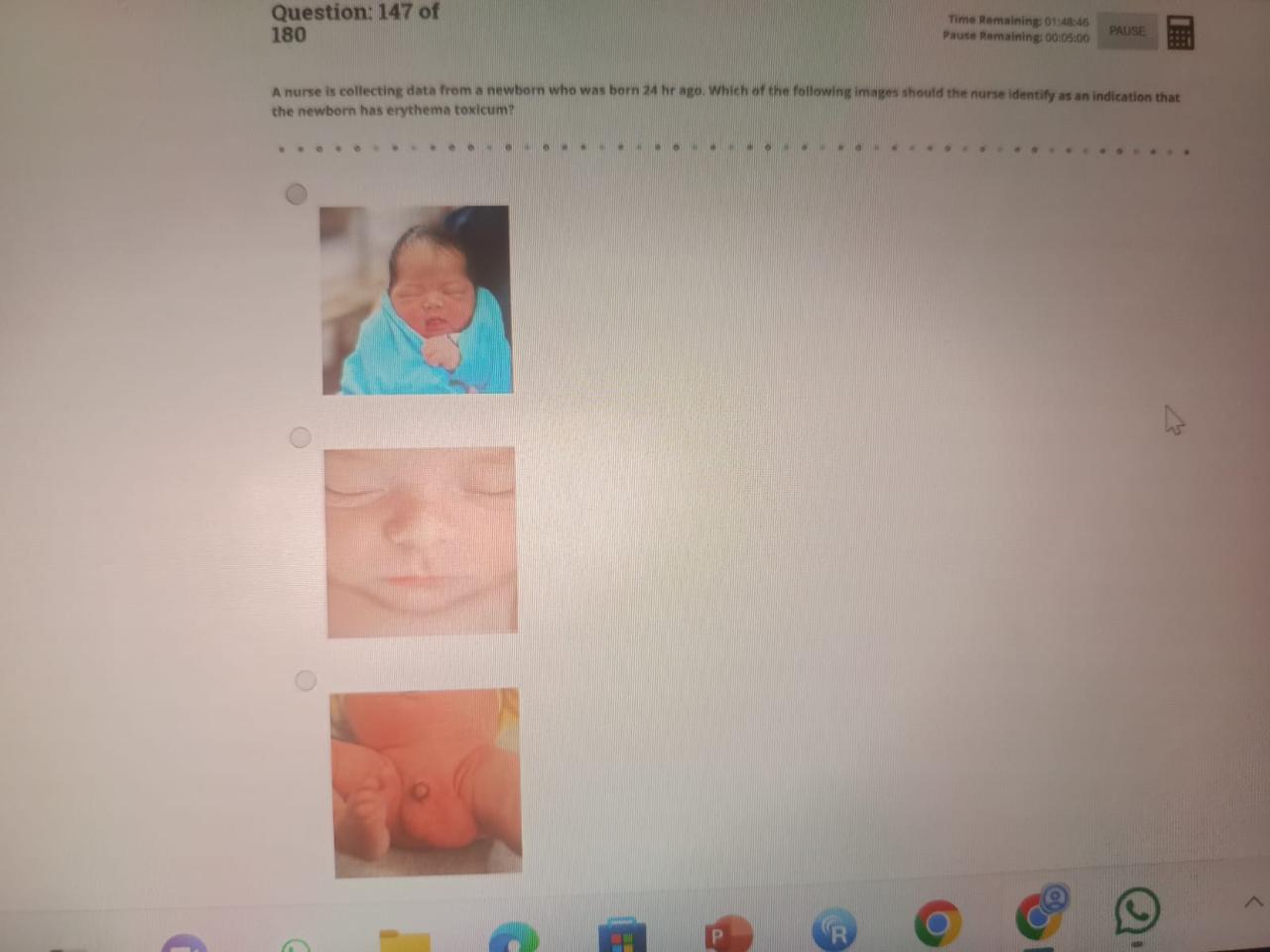A nurse is collecting data from a newborn who was born 24 hr ago. Which of the following images should the nurse identify as an indication that the newborn has erythema toxicum?

A
B
C
The Correct Answer is B
Rationale:
A. This image shows a newborn with normal skin tone and no visible skin lesions. There are no signs of erythema, pustules, or macules that would suggest erythema toxicum.
B. This image displays multiple small, erythematous macules and papules, especially on the face. These are classic signs of erythema toxicum neonatorum, a common and harmless rash seen in the first days of life.
C. The newborn in this image has generally red skin, which could be due to normal newborn circulation changes or mild erythema, but it lacks the distinctive papular or pustular rash pattern seen in erythema toxicum.
Nursing Test Bank
Naxlex Comprehensive Predictor Exams
Related Questions
Correct Answer is B
Explanation
Rationale:
A. Collecting a clean catch urine specimen: This is within the nurse’s scope of practice and is a routine part of preoperative preparation to screen for infection or other abnormalities before surgery.
B. Explaining the risks of the procedure: Explaining surgical risks is the responsibility of the provider performing the procedure. Nurses may reinforce information but are not authorized to introduce or explain risks, as this constitutes part of informed consent.
C. Reinforcing preoperative teaching: Reinforcement of teaching provided by the surgeon or anesthesiologist is within the nurse’s role. The nurse can clarify instructions or ensure the client understands how to prepare for surgery based on what was already explained.
D. Performing a preoperative skin preparation: Nurses are responsible for tasks like preoperative skin prep, which helps reduce infection risk. This is a common nursing duty that supports surgical readiness.
Correct Answer is ["B","C","D"]
Explanation
Rationale:
A. Decreased skin turgor: Decreased skin turgor is a sign of dehydration or fluid imbalance and is not related to compartment syndrome. It does not reflect changes in perfusion or nerve compression caused by increased compartment pressure.
B. Sensation of tingling: Tingling or paresthesia is an early sign of nerve compression due to rising pressure within a muscle compartment. It indicates compromised nerve function and is a key symptom of evolving compartment syndrome.
C. Diminished capillary refill: Delayed or diminished capillary refill suggests impaired perfusion. In a newly placed cast, this can indicate increased pressure restricting blood flow—an early and critical sign of compartment syndrome.
D. Pale-colored toes: Pallor in the extremities is a sign of decreased arterial blood flow. Pale-colored toes after cast placement suggest compromised circulation, which is consistent with compartment syndrome.
E. Pain relieved by analgesia: Pain that is unrelieved by analgesia especially pain out of proportion to the injury is a hallmark of compartment syndrome. Pain that is relieved by medication does not indicate compartment syndrome and may reflect expected postoperative discomfort.
Whether you are a student looking to ace your exams or a practicing nurse seeking to enhance your expertise , our nursing education contents will empower you with the confidence and competence to make a difference in the lives of patients and become a respected leader in the healthcare field.
Visit Naxlex, invest in your future and unlock endless possibilities with our unparalleled nursing education contents today
Report Wrong Answer on the Current Question
Do you disagree with the answer? If yes, what is your expected answer? Explain.
Kindly be descriptive with the issue you are facing.
